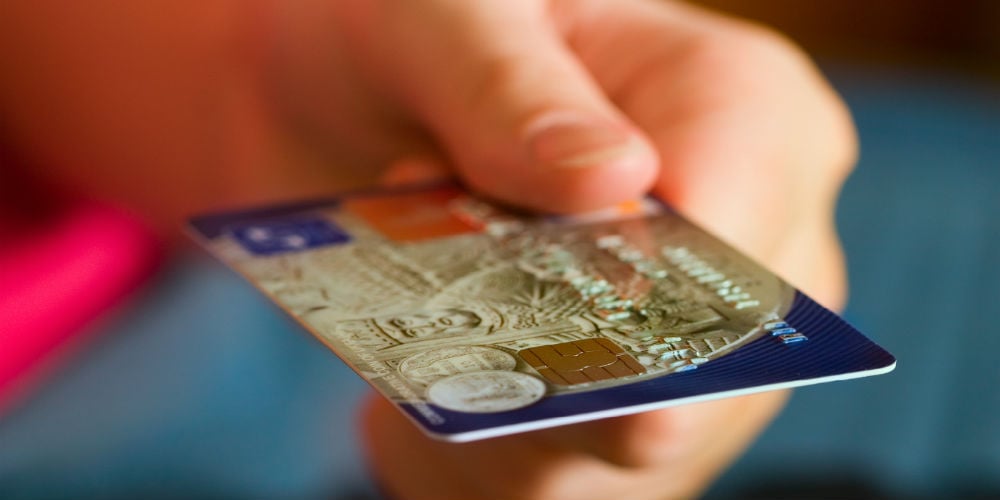EMVs: More security, but at what cost?

EMV chip cards have long been the standard for global electronic payment anti-fraud technology in just about every developed country in the world except the United States — until now. An Executive Order issued by the President last October to help drive the market toward more secure payment systems, combined with efforts from the private sector and payment networks MasterCard, Visa, Discover and American Express, have given U.S. card issuers and merchants a quick kick in the pants — and the pockets — as an incentive to make the switch
As of October 1, 2015, if a fraudulent in-store transaction occurs, the liability will fall on the issuing financial institution or the merchant that is the least EMV-compliant. That means card issuers and merchants who don’t play the EMV payment game are potentially on the hook for a bunch of moola.
What’s the cost for credit unions?
Unfortunately, EMV chip technology comes with a pretty hefty initial price tag. Where traditional magnetic stripe cards typically cost about $0.15 to provide to consumers, EMV chip cards run anywhere from $2 to $4.
That’s a significant increase, which begs the question: Is the change worth the change?
Potentially. Converting to EMV chip technology protects financial institutions from huge liability. In the event of a large data breach, covering the cost of fraud could be astronomical. In 2014, Aite Group estimated that fraud cost an estimated $8.6 billion — and they believe it’s slated to rise. That’s a tab community financial institutions cannot afford to pick up.
Are EMVs really that much more secure?
Yes and no.
EMVs are certainly head and shoulders above the competition when it comes to in-store purchases. That’s because EMV chip cards create a unique transaction code for every new purchase; the code cannot be used again, so there’s no point in fraudsters duplicating the information. Conversely, cards with magnetic stripes contain static data. Anyone who accesses the data on the magnetic stripe can use it over and over again.
But this major benefit doesn’t carry over to card-not-present purchases (like online purchases), which account for a rapidly growing portion of the retail space. And experts are predicting that the introduction of EMV chip card technology is going to cause a significant rise in card-not-present fraud — up to a 20% increase.
That’s because every country that’s adopted EMV chip card technology has seen a similar rise in card-not-present fraud. Where there’s a will, there’s a way — thieves will capitalize where they can.
The silver (dollar) lining
Because of their heavy focus on relationship-based service, credit unions are in a unique position to educate their members about the new technology in a way that benefits the community and, in turn, elevates their brand.
Megabanks can’t hold a candle to the level of personalization a credit union can bring to every member interaction. That makes the switch to EMV technology a huge opportunity for credit unions to differentiate themselves from the big guys.
Proactively educating members about EMV chip card technology is an excellent way to strengthen members’ trust, ultimately increasing loyalty, retention and engagement.
Teaching the ABCs of EMVs
Make sure your members are fully prepared for the switch:
- Announce that you’re providing EMV chip payment cards (or that you soon will be).
- Explain that EMV chip payment cards are much more secure for in-store purchases than their magnetic stripe predecessors, but aren’t necessarily more secure for online purchases.
- Instruct members to dip their cards when making in-store purchases whenever possible (instead of swiping) in order to take advantage of the heightened security.
- Assure members that if a merchant doesn’t have the capacity to run the transaction as an EMV chip card purchase, they shouldn’t worry. As consumers, they will not be held liable for any fraudulent activity.
- Advise members about smart online shopping practices. They should only make online purchases from familiar, trusted websites, and should always look for the lock symbol before completing a transaction. The lock symbol means that the website uses SSL encryption, which helps protect their private information from prying eyes.
Do the dip
Regardless of whether or not we’ll see a big enough reduction in transactional fraud to justify the perceived cost of switching to EMV chip cards, the change is here. And their large scale adoption is going to affect consumer behavior and expectations in ways that make offering them decidedly in credit unions’ best interest.
Members will eventually associate EMV chips with additional security, and stripe-only cards with a high risk for fraud. When it comes to people’s perceptions on transactional safety, credit unions will want to be on the secure side of the fence. Once there, they’ll want to be sure to communicate the news with their membership base — and remind them to keep their credit union issued EMV card top-of-wallet.





